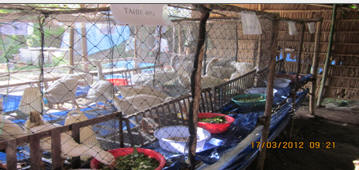 |
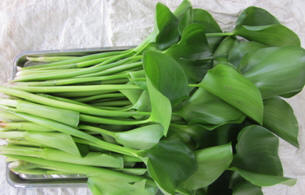 |
 |
| Photo 1. Housing for the geese |
Photo 2:
Water hyacinth for experiment |
Photo 3:
Chopped water hyacinth |
| Back to contents |
Effect of fresh water hyacinth (Eichhornia craszsipes L.) in the diets on growth rate, nutrient digestibility and economic analysis of local goose in the Mekong delta of Vietnam
Nguyen Thi Kim Dong and Nguyen Van Thu
Cantho University, Vietnam
Email: ntkdong@ctu.edu.vn
Abstract
A study was carried out aiming to evaluate the utilization capacity of water hyacinth in the diet of local goose. It was a complete randomized design with 5 treatments corresponding to 5 diets and 3 replications. Four geese balancing in sex were used in one experimental unit. The treatments included C100, C85, C70, C55 and C40 corresponding to the concentrate (rice bran, soybean, bone meal and vitamin premixes) fed geese at the level of 100, 85, 70, 55 and 40 % (based on the C100 diet), while the water hyacinth was offered ad libitum.
The results shown that the reduction of concentrate of 100, 85, 70, 55 and 40 % in the geese diets corresponded to the daily average concentrate intakes of 263, 225, 184, 146 and 106 g DM, respectively. This resulted in the increase of water hyacinth intakes of 0, 23.5, 34.5, 43.6 and 37.9 g DM, respectively. The intakes of DM, OM, CP, NDF, CF, EE and ME were significantly different (P<0.05) among the treatments and they were gradually reduced when the water hyacinth intake increased. The final live weight was not significantly different (P>0.05) for the C100, C85, C70 and C55 treatments, and they were 4458, 4214, 4071 and 3861 g/goose, respectively. The daily weight gain (DWG) was not significantly different (P>0.05) among the C100, C85 and C70 treatments. Apparent feed and nutrient digestibility and digestible nutrients were significantly different (P<0.05) among the treatments and their values were gradually reduced from C100 to C40. However, the economic analysis indicated that despite the DWG was gradually reduced, the profit was increased when increasing water hyacinth in the diets from C100 to C40 due to the feed cost reduction. It was concluded that water hyacinth could be used for feeding local goose together with concentrate, and reduction of concentrate in the diet at the level of 70 and 55 % by feeding ad libitum water hyacinth could give better profits.
Key words: Economic return, forage supplementation, growth rate, meat goose
Introduction
Geese are an important livestock commodity for Asian villagers since most of them are small farmers. Goose raising is frequently done as a backyard farming activity by using cheap and locally available feedstuffs. Developing geese husbandry is advantageous because geese have a fast growth rate; a low feed conversion ratio; the capacity to effectively utilize rations with low levels of crude protein; an ability to digest forages and to obtain them by grazing on pasture; a high resistance to disease (Yuwanta, 1999). Water hyacinth, which large bio-mass and fast growing with productivity about 150 ton/ha/year (Nguyen Bich Ngoc, 2000), and good crude protein (11.7 %) and ME supply (8.29 MJ/kgDM), is available in almost canals and rivers in Mekong Delta, and has been used for pig and poultry feeding. In recent year, water hyacinth has been concerned as a potential feed for cattle, sheep, goats and rabbits (Nguyen Van Thu, 2010). There were many studies of using water hyacinth for ruminants in the world but it was rarely in Vietnam, especially for poultry.
Local geese have been raised for a long time in the Mekong delta of Vietnam. They are mainly raised in small farmers’ households for meat, eggs and housing keeping based on forages such as natural grasses, legume foliages, banana trunk, vegetable wastes, and supplemented a small amount of paddy rice, rice bran and broken rice with the daily weight gain around 50g/animal and high profit (Farmer communication, 2010). They are grazed in pasture, or in fruit gardens with surrounding by nylon nets, and consume not only grasses, but also insect, snail, worms, etc. which can provide 10% of their total protein intake (Buckland and Guy, 2002). Local geese have ability to utilize high-fiber feeds and thus use a variety of types of forages, due to large muscular proventriculus, well-muscled gizzard and microbial breakdown of fiber well in caecum and large intestine. The rates of digestion of acid digestive fiber of the geese are from 15-30% depending on the feed materials (Buckland and Guy, 2002). Thus goose production has potential perspective and suitability in order to supply organic farming products and small farmers economic improvement. Despite usefulness of the local goose they have been ignorant in research because of their raising by poor farmers in remote villages. Therefore, an understanding and determining the relevant goose rations, which contain optimal levels of this forage to suitable growth rate and better economic return being very useful for researchers and small-holder farmers.
Materials and methods
Location and climate
The experiment was conducted in the experimental farm at 447C/18, Binh An hamlet, Long Hoa village, Binh Thuy district, Cantho City of Vietnam, during the dry season, from December, 2011 to April, 2012. Environmental temperature during the experiment averaged 27.5 °C, 35.5 °C and 27. 5°C at 6 AM, 12 AM and 6 PM, respectively. The chemical analysis of feeds, refusals and excreta were done at the laboratory of the Department of Animal sciences, Faculty of Agriculture & Applied Biology of Cantho University.
Experimental design and treatments
Sixty local geese at 5 weeks of age (from 1362 to 1390 g/bird) were allotted in a completely randomized design with 5 treatments and 3 replicates, and 4 birds per experimental unit (sexual balance). The treatments were C100, C85, C70, C55 and C40 corresponding to the concentrate (85% rice bran, 14% soybean, 1% bone meal and 0.25% vitamin premixes) fed geese at the level of 100, 85, 70, 55 and 40 % (based on the C100 diet), while the water hyacinth was offered ad libitum. The measurement of nutrient digestibility was done when geese were at 12 weeks of age (around 3200 g/bird). The trial was lasted for 11 weeks and the diets offered to the treatment was weekly adjusted by an increase from 5 % to 10% according to actual feed intake.
Experimental animals, housing and management
Experimental geese were raised in cages (4m2 each cage and each pen accommodated 4 geese) constructed in a simple house (local materials). The cage floor was made by bamboo with 1 m height from the soil surface. Feeders and drinkers were put in front of each cage.
 |
 |
 |
| Photo 1. Housing for the geese |
Photo 2:
Water hyacinth for experiment |
Photo 3:
Chopped water hyacinth |
|
Table 1: Feed ingredient composition (%DM) in the diets for goose of Exp. |
|||||
|
Treatment |
|||||
|
|
C100 |
C85 |
C70 |
C55 |
C40 |
|
Concentrate |
100 |
85 |
70 |
55 |
40 |
|
Water hyacinth |
- |
Ad lib. |
Ad lib. |
Ad lib. |
Ad lib. |
|
C100, C85, C70, C55 and C40: Concentrate percentage level of 100, 85, 70, 55 and 40 of the diet, respectively, and while water hyacinth fed in ad libitum. |
|||||
Feed and feeding
Stems and leaves of water hyacinth were chopped in small pieces (1.0 – 1.5 cm) for feeding. Geese were fed 4 times a day with concentrate and chopped water hyacinth in separation (at 8, 10, 14 and 18.00 h) for an easy collection of refusals. Water was freely available.
Chemical analyses
Feeds offered and refusals were analyzed for chemical compositions: DM, OM, CP, EE, CF, Ash. These were analyzed following procedures of AOAC (1990). NDF analysis was followed the Van Soest et al (1991) and ME was calculated by Janssen (1989) and Maertens et al (2002).
Measurements taken:
- Daily intakes of feed and nutrients (DM, OM, CP, NDF, and ME).
- Growth rate, feed conversion ratio and economic analysis
- Feed and nutrient digestibility suggested by Mc Donald et al (2002)
Data were analyzed by General Linear Model (GLM) of Minitab program 13.21 (Minitab, 2000) and the comparison of significant difference between two treatments was done by Tukey method of Minitab program.
Results and discussion
Chemical composition of feeds
The chemical composition of feeds used in the experiment is shown in Table 2.
|
Table 2: Chemical composition of the feeds (%DM) |
||||||||
|
|
DM |
OM |
CP |
EE |
CF |
NDF |
Ash |
ME, MJ/kgDM |
|
Rice bran |
95.0 |
89.9 |
13.2 |
11.5 |
10.5 |
28.2 |
10.1 |
10.4* |
|
Soybean meal |
90.4 |
93.6 |
43.6 |
11.4 |
9.57 |
17.8 |
6.4 |
12.1* |
|
Water hyacinth |
7.38 |
82.6 |
12.9 |
2.31 |
23.0 |
56.6 |
17.4 |
8.26** |
|
Bone meal |
96.1 |
32.2 |
21.8 |
5.34 |
- |
- |
67.8 |
5.84* |
|
DM: dry matter, CP: crude protein, N: nitrogen, OM: organic matter, CF: crude fiber, EE: Ether extract NDF: neutral detergent fiber . * calculated by Janssen (1989) and ** by Maertens et al (2002) . |
||||||||
Crude protein of rice ban was 13.2 %, higher than reports by Dang Hung Cuong (2011) and Tran Nhat Tien (2011) being 11.0 and 11.6 %, respectively. The CP of soybean meal was 43.6% and ME of rice bran and soybean meal was 10.4 and 12.1 MJ/kg DM, respectively. The DM of water hyacinth was 7.38 %, similar to report of Nguyen Van Thu (2009). The CP of Water hyacinth was 12.9 % and consistent to report of Nguyen Thi Dan Thanh (2010) being 12.3 %. The NDF of water hyacinth was 56.6 % in this study and it was in agreement with reported by Nguyen Van Thu and Nguyen Thi Kim Dong (2009) being 57.3 %. The water hyacinth ME value in the present study was consistent of 8.26 reported of Ton That Thinh (2010).
Feed and nutrient intakes
The daily feed and nutrient intake of geese in different treatments of the experiment were presented in Table 3.
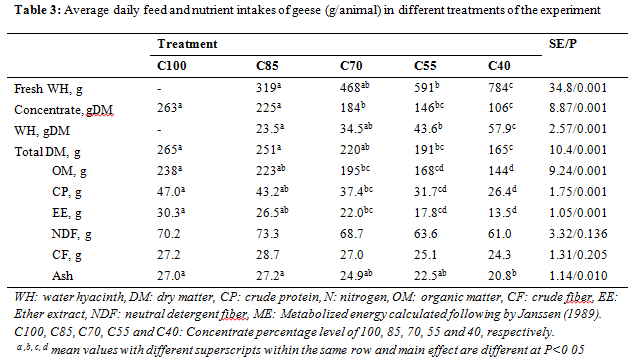
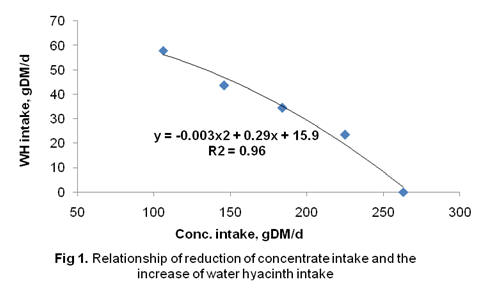 |
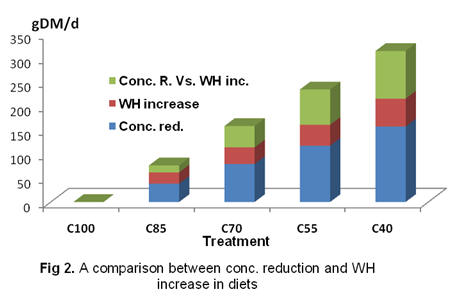 |
|
The reduction of concentrate levels of 100, 85, 70, 55 and 40 % in the geese diets corresponded to the average concentrate intakes of 263, 225, 184, 146 and 106 gDM/d, respectively. This resulted in the increase of water hyacinth intakes of 0, 23.5, 34.5, 43.6 and 57.9 gDM/d, respectively (Table 3 & Fig. 1) corresponding to the 0, 9.44, 15.7, 22.8 and 35.1 % (dietary DM intake), respectively. However, there was a greater reduction of concentrate (gDM) compared to the increase of water hyacinth (Fig 2). The intakes of DM, OM, CP, NDF, EE, CF, and ME were significantly different (P<0.05) among the treatments and they were gradually reduced when the water hyacinth intake increased (Table 3, Fig. 3 and Fig.4).
 |
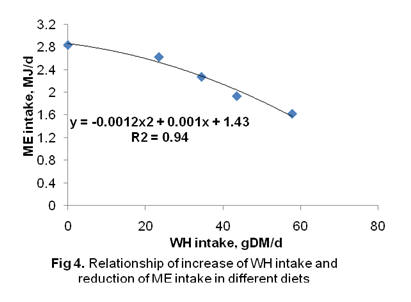 |
Daily weight gain (DWG) and feed conversion ratio (FCR)
The final live weight, daily weight gain and feed conversion ratio of the experimental geese were shown in Table 4.
|
Table 4: Final live weight, daily weight gain (DWG) and feed conversion ratio (FCR) of the geese in different treatments of the experiment |
||||||
|
|
Treatment |
SE/P |
||||
|
C100 |
C85 |
C70 |
C55 |
C40 |
||
|
Initial LW, g |
1362 |
1366 |
1390 |
1362 |
1348 |
10.2/0.14 |
|
Final LW, g |
4458a |
4214a |
4071ab |
3861ab |
3435b |
143/0.005 |
|
Daily weight gain |
40.2a |
37.0ab |
34.8ab |
32.5bc |
27.1c |
1.45/0.001 |
|
CP/kg WG,g |
1171 |
1175 |
1070 |
976 |
978 |
55.7/0.067 |
|
ME/Kg WG, MJ |
70.6 |
71.2 |
65.0 |
59.5 |
60.0 |
3.40/0.093 |
|
FCR |
6.61 |
6.81 |
6.31 |
5.88 |
6.11 |
0.34/0.356 |
|
C100, C85, C70, C55 and C40: Concentrate percentage level of
100, 85, 70, 55 and 40, respectively. |
||||||
There were significant differences (P<0.05) in final live weight and daily weight gain among the treatments and they were gradually reduced when increasing the water hyacinth intake, and reducing the concentrate feed. The DWG value was significantly higher for the C100 as compared to the C55 and C40 treatments (40.2 g Vs. 32.5 and 27.1 g). Tong Thi My Ha (1985) stated that the DWG of local geese was 38.4 g. The final live weight was not significantly different (P>0.05) for the C100, C85, C70 and C55 treatments, and it was 4458, 4214, 4071 and 3861 g, respectively. These results were consistent with values of the local geese reported by Viet Linh (2005) with final live weight of 3440 g. In the present study the DWG was not significantly different (P>0.05) among the C100, C85 and C70 treatments, while there was a significantly higher value (P<0.05) for the C100 than C40 treatment. The FCR was not significantly different (P>0.05) among the treatments, however there were, numerically, the lower values for C70, C55 and C40 treatments, respectively.
Apparent feed and nutrient digestibility
The apparent feed and nutrient digestibility of geese was presented in Table 5.
|
Table 5: Feed and nutrient digestibility and nitrogen retention of geese in the experiment |
||||||
|
|
Treatment |
SE/P |
||||
|
C100 |
C85 |
C70 |
C55 |
C40 |
||
|
Digestibility, % |
|
|
|
|
|
|
|
DMD |
79.8a |
75.6a |
71.9ab |
61.3b |
59.7b |
3.70/0.003 |
|
OMD |
82.0a |
77.4a |
73.3ab |
63.4b |
62.7b |
2.74/0.002 |
|
NDFD |
60.4a |
53.5ab |
51.3ab |
45.1ab |
35.6b |
4.78/0.038 |
|
Digestible nutrients, g |
||||||
|
DDM |
228a |
198ab |
179b |
125c |
107c |
7.40/0.001 |
|
DOM |
211a |
181ab |
163b |
115c |
101c |
6.21/0.001 |
|
DNDF |
45.5a |
40.7a |
38.0ab |
28.1bc |
20.2c |
2.39/0.001 |
|
N intake |
6.11a |
5.31a |
4.93a |
3.66b |
2.99b |
0.26/0.001 |
|
N intake/LW0.75 |
2.67a |
2.51ab |
2.56ab |
2.16ab |
1.84b |
0.16/0.021 |
|
N retention |
4.68a |
3.89ab |
3.39b |
2.25c |
1.80c |
0.18/0.001 |
|
N retention/LW0.75 |
2.06a |
1.83ab |
1.76ab |
1.33bc |
1.11c |
0.13/0.003 |
|
C100, C85, C70, C55 and C40: Concentrate percentage level of
100, 85, 70, 55 and 40, respectively. |
||||||
Generally they were significantly different (P<0.05) among the treatments and their values were gradually reduced from the C100 to C40 diets. The DDM was 228, 198, 179, 125 g and 107 g for the C100, C85, C70, C55 and C40 treatments, respectively. The DDM of C100, C85 and C70 treatment was significantly higher (P<0.05) than that of C55 and C40 treatments. The DNDF was 45.5, 40.7, 38.0, 28.1 and 20.2 g for the C100, C85, C70, C55 and C40 treatments, respectively. The DNDF of C100 and C85 treatments was significantly higher (P<0.05) than C55 and C40 treatments. These results of NDF digestibility were similar to those of geese reported by Zang et al (2006). Nitrogen intake was significantly (P<0.05) reduced among the treatments. Similarly, the nitrogen retention was significantly different (P<0.05) among the treatments and they were 2.06, 1.83, 1.76, 1.33 and 1.11 g/LW0.75 for the C100, C85, C70, C55 and C40 treatments, respectively. In summary, the results of apparent nutrient digestibility and nitrogen retention values generally corresponded to the growth rate of geese in treatments of the present study.
Economic analysis
In Table 6 the expenses of geese chick, feeds and veterinary medicine, income and profit of geese were stated.
|
Table 6: The economic analysis (thousand VND/goose) in the different treatments |
|||||
|
|
Treatment |
||||
|
C100 |
C85 |
C70 |
C55 |
C40 |
|
|
Geese chick |
50.0 |
50.0 |
50.0 |
50.0 |
50.0 |
|
Feed |
151 |
129 |
106 |
83.6 |
60.7 |
|
Vet. Medicine |
5.0 |
5.0 |
5.0 |
5.0 |
5.0 |
|
Total expenses |
206 |
184 |
161 |
139 |
116 |
|
Total income |
357 |
337 |
326 |
309 |
275 |
|
Profit |
151 |
153 |
165 |
170 |
159 |
|
Profit (%) compared to C100 |
100 |
101 |
109 |
113 |
105 |
|
% profit/total expense |
73.3 |
83.1 |
102 |
123 |
138 |
|
Notes: Prices for geese: 80,000 VND/kgLW, fresh water hyacinth: 200 VND/kg, soybean: 16,000 VND/kg, rice bran: 5000 VND/kg, premix vitamin: 95,000 VND/kg and bone meal: 10,000 VND/kg. |
|||||
The economic analysis of present study showed that despite the daily weight gain was gradually reduced, the profit was increased when increasing water hyacinth in the diets from C100 to C40. They were 151,000, 153,000, 165,000, 170,000 and 159,000 VND per goose for the C100, C85, C70, C55 and C40, respectively. This could be explained by the reduction of concentrate expenses and the utilization of water hyacinth of local geese for their relevant growth rate. Especially, the C70 and C55 treatments gave better profits as compared to the others.
Conclusions and implications
It was concluded that:
- Stems and leaves of water hyacinth could be used for feeding local goose together with concentrate reduction in the diets.
- There were gradual reduction of daily weight gain and digestible nutrients when increasing the water hyacinth intake. However the reduction of concentrate in the diet at the levels of 70 and 55 % by feeding water hyacinth ad libitum gave the better profits in local geese.
Acknowledgement
The authors thank to MEKARN project for funding this study, Dr. TR Preston for his valuable advices and Department of Animal Sciences, Fac. of Agric. & Appl. Biology of Cantho University, Vietnam for facilitating the experiments.
References
AOAC 1990 Official methods of analysis (15th edition), Washington, DC, Volume 1: 69-90
Buckland R. and Guy G 2002 Goose production, FAO Animal Production and Health Paper 154. FAO, Rome, Italy, pp 146
Janssen W M M A 1989 European Table of Energy Values for Poultry Feedstuffs. 3rd ed. Beekbergen, Netherlands: Spelderholt Center for Poultry Research and Information Service
Maertens L, Perez J L, Villamide M, Cervera C, Gidenne and Xiccato G 2002 Nutritive value of raw materials for rabbit. EGRAN tables 2002. World Rabbit Sci. 10, pp 157-166
Mc Donald P, Edwards R A , Greehalgh J F D and Morgan C A 2002 Digestibility evaluation of foods, Animal Nutrition, 6th edition, Longman Scientific and technical, New York, pp. 245 - 255
Minitab 2000 Minitab reference manual release 13.21, Minitab Inc.
Nguyen Bich Ngoc 2000 Nutritive values of plants for animal feeds (Vietnamese) . Van Hoa - Dan Toc Publishing house. Ha Noi, Vietnam
Nguyen Thi Đan Thanh 2010 Effects of replacement of Para grass by water hyacinth (Eichhornia craszsipes L.) on nutrient utilization , rumen parameters and nitrogen retention in cattle and buffalo. MSc Thesis (Vietnamese). Fac. Of Agric. & Appl. Biology, Cantho University
Nguyen Van Thu 2010 Effects of different levels of freshwater hyacinth (Eichhornia craszsipes L.) in the diets on feed utilization and digestibility, rumen parameters and microbial protein synthesis in goat. In MEKARN proceedings. International Conference. Live stock production, climate change and resource depletion. 9 - 11 November 2010 in Pakse, Laos
Nguyen Van Thu and Nguyen Thi Kim Dong 2009 A study of water hyacinth (Eichhornia craszsipes L.) as a feed resource for feeding growing rabbits. In Proceeding of International Workshop Livestock, Climate change and the Environment. MEKARN Project. Angiang University 11-2009. VIETNAM. http://www.mekarn.org/ workshops/environ/proenv/Thuctu.htm
Ton That Thinh 2010 Effects of different water hyacinth supplement (Eichhornia craszsipes L.) levels on growth rate , nutrient digestibility and economic return of Guinea fowl. MSc Thesis (Vietnamese). Fac. Of Agric. & Appl. Biology, Camtho University
Tong The My Ha 1985 A comparison of different strategies of meat goose raising from 21 – 90 days of age under low quality diets at SOHA farm. Bask thesis (Vietnamese). Fac. Of Agric. & Appl. Biology, Camtho University
Tran Nhut Tien 2011 An observation the hatchability of Guinea fowl eggs by feeding diets with different ratio of maize and rice bran. BSc Thesis (Vietnamese). Fac. Of Agric. & Appl. Biology, Cantho University
Viet Linh 2005 Raising geese technology (Vietnamese). http://www.vietlinh.com.vn/ library/agriculture_ livestock_poultry/ngong.htm
Zhang S, Guo J, Tang Q, Zou J, Li H, Zhu C, Lu H, Su J, Tan W and Xu G 2011 Metabolizable Energy and Fiber Digestibility Values of 11 Unconventional Feedstuffs for Geese. Chinese Journal of Animal Nutrition. 2011- 11-011. http://en.cnki.com.cn/Article _en/CJFDTOTAL-DWYX201111011.htm
Yuwanta T 2002 Goose production in Indonesia and Asia. FAO publication. ftp://ftp.fao.org/docrep/fao/ 005/y4359e/Y4359e17.pdf